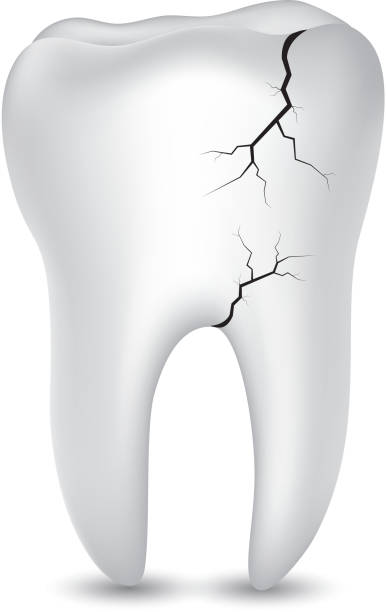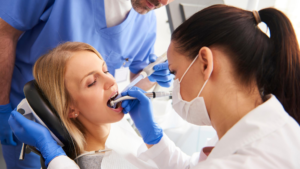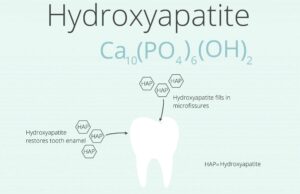Enamel, the most mineralized tissue covering teeth, is the hardest part of your body, but it has its own limit and it could crack or chip under extreme pressure. If chewing is causing pain or eating hot or cold food items causing a sensation, then your molar might have cracked. Cracks in the molar might not be visible, but if you are experiencing pain or sensation you should consult your dentist immediately so that he could fix it using a suitable treatment.
What Are The Symptoms of Cracked Molar?
The dental system is highly complex and interlinked, so any tooth damage can lead to pain and discomfort if left untreated for long. You might not even see any specific symptom other than temporary pain and sensation, but if not treated it could lead to tooth decay. Some of the common symptoms of a cracked molar or rather cracked tooth are:
- Mild pain when applying extra force in chewing or biting
- In some cases, it could cause gum swelling around a cracked molar
- Crack in molar could make it sensitive to sweetness and acidic foods
- You might feel sensation with hot or cold food and drink items
- Inconsistent pain around affected teeth
- Eating discomfort
What Might Cause Molar to Crack?
Teeth are anatomically strong enough to ensure normal oral functionalities. Apart from normal age-related wear and tear, you molar might crack or break due to various reason, including:
- Excessive grinding could accelerate enamel erosion, thus making teeth vulnerable to breakage
- If your teeth are weak, chewing hard food items like nuts and ice could cause cracks
- If cavity fillings are large, it could weaken the natural strength of your molar
- A physical injury could cause cracks on molars
- Abrupt temperature changes, like having ice cream just after the hot soup, could cause cracks on the tooth
- Age-related natural weakening of the dental structure
Types of Cracked Molar
A molar crack or rather a tooth crack is very common among old age people, especially women over 40 years. Depending on the cause of molar cracks, the depth, length, and location could vary. Most common of all is the craze line, the smallest cracks within tooth enamel, and it rarely needs treatment. Dental care professionals classify tooth cracks into the following types:
Oblique Supra and Subgingival Cracks: Depending on the depth of cracks, it could be supra and subgingival. If cracks are limited to the crown, meaning it hasn’t extended below the gum line, it is called supragingival cracks. If cracks extend below the gum line, it could cause extreme pain. The treatment involves exposing the crown and restoring the tooth.
Split Molar: If the crack starts from the surface and extends below the gum line, it could split the tooth into two parts. In such cases, it is challenging to protect the whole tooth, so your dentist might recommend saving the tooth partially and restore the tooth with a crown. If required, your dentist might recommend root canal treatment.
Oblique Root Cracks: If cracks are below the gum line, not on the surface, it could cause pain in discomfort. Unfortunately, there is no way to restore tooth oblique root cracks and dentists often recommend tooth extraction to alleviate frequent pain and discomfort.
Fractured Cusp: More common around dental fillings, these cracks could lead to breakage of some part of the molar chewing surface.
Vertical Apical Root Cracks: As the name suggests, cracks start from the root and extend upwards. You won’t notice any serious symptoms unless the molar is infected. In most cases, dentists recommend molar extraction for better dental functionalities.
How Are Cracked Teeth Diagnosed?
If you notice symptoms related to a cracked molar, you should consult your dentist immediately. He will ask some questions related to recent activities and medical history and examine the affected tooth physically. If cracks aren’t visible, he will conduct certain advanced tests to find the location, depth, and size of the crack. Your dentist will use a dental explorer to find cracks on the surface. In some cases, the dentist might use dental dye to make cracks more visible.
Since cracks irritate the gum, your dentist might check gums for any sign of irritation. For deep-rooted cracks, he might recommend an x-ray to detect any abnormality in the pulp of your tooth.
When Should You See Your Dentist?
Ideally, you should consult your dentist as soon as you notice cracked molar symptoms. A cracked molar will affect the normal functioning of your dental system with pain and discomfort, so it is better to seek your dentist’s advice at the earliest. Early dental intervention can help you save the teeth. If you cannot see your doctor immediately, follow these tips to relieve pain:
- Rinse your mouth with warm water to avoid infection
- If pain is unbearable, you can take OTC pain relievers
- If cracks are due to impact, you can try a cold compress to ease inflammation
- If there is a sharp edge, you can dry orthodontic wax to protect soft tissues
- Avoid eating any hard food for the time being
- Keep your oral space bacteria-free by following standard oral care practices
What are the Treatment Options for Cracked Molar?
Once your dentist is done with the diagnosis, he will tell in detail about possible causes and available treatment options. The treatment will depend on the type, location, depth, size, and severity of cracks. If cracks are minor and on the surface, meaning, the gum line isn’t affected, you might not need any treatment other than regular cleaning and care. If cracks are deep-rooted and gum line is affected, your dentist might recommend these treatments for molar cracks to save your affected molar or protect surrounding teeth:
Dental Filling and Bonding
If the crack is on the surface your dentist might recommend a dental bonding procedure to restore the look and function of your tooth. A tooth-colored plastic resin material is used to fill the crack. If the enamel of your molar has chipped off, the dentist might repair it by filling the affected area.
For bonding, your dentist will first etch the surface to make it a little rough and then apply suitable adhesive before placing plastic resin material. For a better feel, your dentist will shape it and then use UV light to harden the material for better durability.
If the molar crack is due to wrong dental filling, your dentist might remove earlier filling and refill the cavity using better material.
Crown
One of the most effective and popular treatments for cracked molars is the crown—a kind of prosthetic device made of ceramic or ceramic, that caps the damaged molar. The procedure involves etching away some enamel to make room for the crown and taking an impression of the affected and surrounding teeth. Once the crown is ready as per specifications, your dentist will fit it over the cracked tooth using suitable cementing material.
Root Canal
If the crack extends downward up to the gum line, then your dentist might recommend root canal treatment. The procedure involves the removal of affected tissues surgically so that tooth could be saved. It will help you save your teeth from infection and possible tooth loss.
Extraction
If the root of the molar is damaged or cracks start from the root or extend upward, your dentist might recommend extraction of the affected molar. It will help you get rid of pain and discomfort. Most importantly, it will help your surrounding teeth as infection could spread and make gums weak, resulting in irreversible tooth decay. You can discuss options available to artificially restore lost molar for better functionalities.
Cost of Treating Cracked Molar
Just like any other dental treatment, the cost of treating a cracked molar will depend on the type of crack, size, depth, and of course the location and reputation of your dentist. Your dentist will diagnose your case and recommend suitable treatment to protect your molar. You can expect to pay the following amount depending on the treatment opted:
- Depending on the complexity the cost of a dental bonding procedure could vary between $100 and$1,000.
- The cost per crown could be in the range of $1,000 to $1,500 per tooth, depending on the material you choose for making the crown and the number of visits required.
- The root canal treatment for molar could be above $1,000. If extraction is recommended, you might have to pay around $200 per molar.
- You might have to pay additional for an x-ray and local anesthesia. You should get in touch with your dental health insurer to discuss possible full or partial coverage.
Does Cracked Molar Hurt?
If your molar is cracked then pain is inevitable. However, the intensity of pain will depend on the cause and depth of the crack. You might not experience much pain and discomfort with minor cracks or small chip-offs. But, if the crack is extensive and deep you will experience unbearable pain, at least in the early days and when chewing hard foods. If the nerve is damaged, you might experience extra sensitivity in response to hot or cold food items. You can use OTC painkillers to control pain and inflammation.
Outlook
No matter what you do, teeth weaken naturally with age. So, some amount of wear and tear is inevitable. It doesn’t mean, one should ignore cracks as it could accelerate enamel erosion leading to permanent tooth loss. Thankfully, you have several options to repair and restore a cracked molar. All you need to do is to consult your dentist at the earliest, a delay could make it difficult for the dentist to save your tooth. If it is not possible to contact the dentist, you should pay special attention to keeping your oral space clean to avoid infection and pain management. An experienced dentist will treat your cracked molar effectively and give you a fully functional molar to enjoy your favorite food without stress.
Sources:
- Chai, H. (2015). On crack growth in molar teeth from contact on the inclined occlusal surface.
https://www.sciencedirect.com/science/article/pii/S1751616114003932 - Barani, A., Bush, M. B., & Lawn, B. R. (2012). Effect of property gradients on enamel fracture in human molar teeth.
https://www.sciencedirect.com/science/article/pii/S175161611200183X - Bajaj, D., Sundaram, N., Nazari, A., & Arola, D. (2006). Age, dehydration and fatigue crack growth in dentin.
https://www.sciencedirect.com/science/article/pii/S0142961205010549 - Seo, D. G., Yi, Y. A., Shin, S. J., & Park, J. W. (2012). Analysis of factors associated with cracked teeth.
https://www.sciencedirect.com/science/article/pii/S0099239911013793


